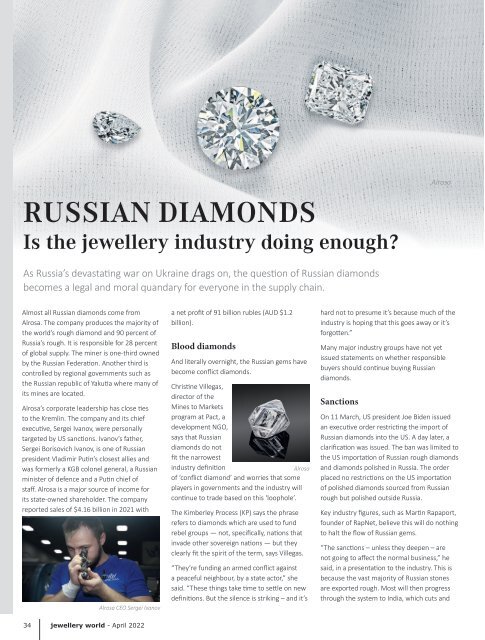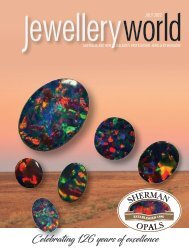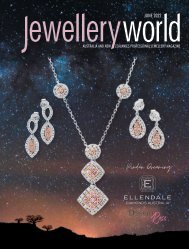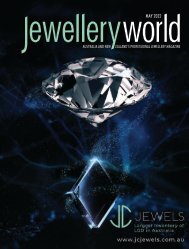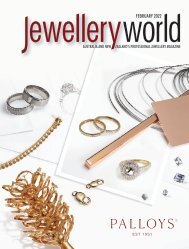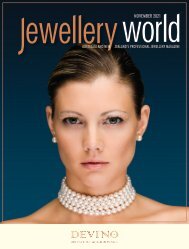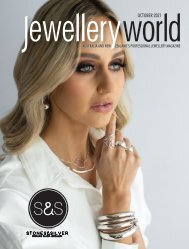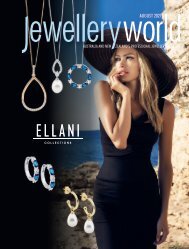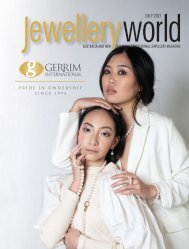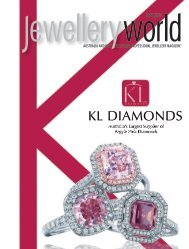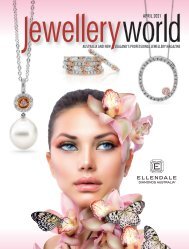Jewellery World Magazine - April 2022
Create successful ePaper yourself
Turn your PDF publications into a flip-book with our unique Google optimized e-Paper software.
Alrosa<br />
RUSSIAN DIAMONDS<br />
Is the jewellery industry doing enough?<br />
As Russia’s devastating war on Ukraine drags on, the question of Russian diamonds<br />
becomes a legal and moral quandary for everyone in the supply chain.<br />
Almost all Russian diamonds come from<br />
Alrosa. The company produces the majority of<br />
the world’s rough diamond and 90 percent of<br />
Russia’s rough. It is responsible for 28 percent<br />
of global supply. The miner is one-third owned<br />
by the Russian Federation. Another third is<br />
controlled by regional governments such as<br />
the Russian republic of Yakutia where many of<br />
its mines are located.<br />
Alrosa’s corporate leadership has close ties<br />
to the Kremlin. The company and its chief<br />
executive, Sergei Ivanov, were personally<br />
targeted by US sanctions. Ivanov’s father,<br />
Sergei Borisovich Ivanov, is one of Russian<br />
president Vladimir Putin’s closest allies and<br />
was formerly a KGB colonel general, a Russian<br />
minister of defence and a Putin chief of<br />
staff. Alrosa is a major source of income for<br />
its state-owned shareholder. The company<br />
reported sales of $4.16 billion in 2021 with<br />
Alrosa CEO Sergei Ivanov<br />
a net profit of 91 billion rubles (AUD $1.2<br />
billion).<br />
Blood diamonds<br />
And literally overnight, the Russian gems have<br />
become conflict diamonds.<br />
Christine Villegas,<br />
director of the<br />
Mines to Markets<br />
program at Pact, a<br />
development NGO,<br />
says that Russian<br />
diamonds do not<br />
fit the narrowest<br />
industry definition<br />
Alrosa<br />
of ‘conflict diamond’ and worries that some<br />
players in governments and the industry will<br />
continue to trade based on this ‘loophole’.<br />
The Kimberley Process (KP) says the phrase<br />
refers to diamonds which are used to fund<br />
rebel groups — not, specifically, nations that<br />
invade other sovereign nations — but they<br />
clearly fit the spirit of the term, says Villegas.<br />
“They’re funding an armed conflict against<br />
a peaceful neighbour, by a state actor,” she<br />
said. “These things take time to settle on new<br />
definitions. But the silence is striking – and it’s<br />
hard not to presume it’s because much of the<br />
industry is hoping that this goes away or it’s<br />
forgotten.”<br />
Many major industry groups have not yet<br />
issued statements on whether responsible<br />
buyers should continue buying Russian<br />
diamonds.<br />
Sanctions<br />
On 11 March, US president Joe Biden issued<br />
an executive order restricting the import of<br />
Russian diamonds into the US. A day later, a<br />
clarification was issued. The ban was limited to<br />
the US importation of Russian rough diamonds<br />
and diamonds polished in Russia. The order<br />
placed no restrictions on the US importation<br />
of polished diamonds sourced from Russian<br />
rough but polished outside Russia.<br />
Key industry figures, such as Martin Rapaport,<br />
founder of RapNet, believe this will do nothing<br />
to halt the flow of Russian gems.<br />
“The sanctions – unless they deepen – are<br />
not going to affect the normal business,” he<br />
said, in a presentation to the industry. This is<br />
because the vast majority of Russian stones<br />
are exported rough. Most will then progress<br />
through the system to India, which cuts and<br />
34<br />
jewellery world - <strong>April</strong> <strong>2022</strong>


